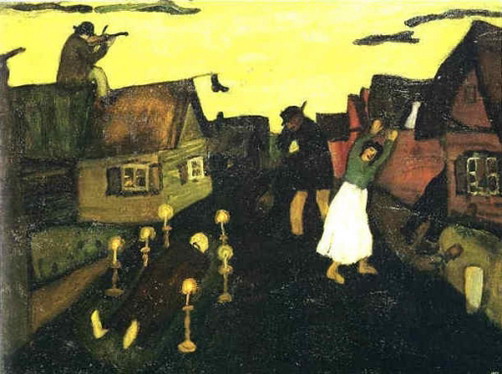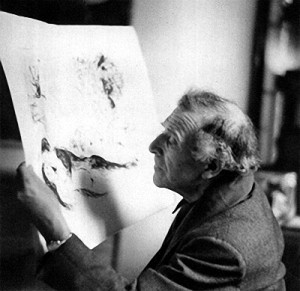In the spirit of Hannukah (and Thanksgivukkah, because that was pretty neat), we look to the painting The Death (1908) by Jewish artist Marc Chagall.
Chagall was born Moishe Segal in the small town of Liozna, Russia in 1887. Life wasn’t easy for the Segal family, in which Moishe was one of nine other young mouths to feed. Chagall’s father worked for a herring merchant, a job that required back-breaking work Chagall later described as “hellish:”
“Day after day, winter and summer, at six o’clock in the morning, my father got up and went off to the synagogue. There he said his usual prayer for some dead man or other. On his return he made ready the samovar, drank some tea and went to work. Hellish work.”
Nevertheless, writes Chagall, there was always “buttered bread [on the table], like an eternal symbol” of nourishment that can only come from the love of a fierce family man. Chagall learned early on that life is demanding – unrelenting, even – by nature. But rather than respond with resignation or bitterness, Chagall’s father found strength and joy in his Jewish faith.
It’s a lucky fact for art lovers that Chagall’s father was so proud of his religion – if not, Chagall might not have been as willing to celebrate his Jewish roots in his own work. Today, the painter’s fame as a pioneer of Cubism and Expressionism is matched only by the height of his pedestal as one of the most important, colorful figures of the Jewish art world.
“It’s a lucky fact for art lovers that Chagall’s father was so proud of his religion – if not, Chagall might not have been as willing to celebrate his Jewish roots in his own work. “
As a painting, The Death presents us with a geometric, expressive interpretation of mourning; we see four figures in the work in a heavily contrasted scene, gathered almost by happenstance for the death of one of their community members. To the right is an aproned woman (his wife?), wailing with her hands in the air; surrounding her is a man – a grave digger, perhaps? The scene is almost too dark to know for certain – and a lone violinst on a rooftop. In the foreground, her recently passed loved one lays beside candle-light – an image of melancholic repose in death.
“In the foreground, her recently passed loved one lays beside candle-light – an image of melancholic repose in death.”
Many paintings famously portray scenes of formal, well-ordered mourning (think The Funeral of St. Stephen by Fra Filippo Lippi). But this work shows a window into a Jewish community’s reaction to the passing of a loved one that feels much more raw, much more open in its expression of pain. Perhaps The Death holds a mirror to Chagall’s own life, intentionally or otherwise, in echoing the harshness of his adolescence. Life was never easy for the painter, or his family — but it was good, it was all the more rewarding. And as melancholy as The Death is, it also incites a kind of comfort in the viewer; a sense of community and the knowledge that although we grieve, we never have to grieve alone.
Related SevenPonds articles:
- Pablo Picasso: Death of Harlequin
- Andy Warhol: A Life in Time Capsules
- The Goodbye Gallery: A Unique Space for Contemporary Art in the Czech Republic

 Marc Chagall: “The Death”
Marc Chagall: “The Death”






 First the Wealth Gap, Now the U.S. Has a Growing Health Gap
First the Wealth Gap, Now the U.S. Has a Growing Health Gap
 How to Comfort A Dying Loved One
How to Comfort A Dying Loved One
 Our Annual Seven Holiday Gifts for Someone Who Is Grieving, 2024 Edition
Our Annual Seven Holiday Gifts for Someone Who Is Grieving, 2024 Edition














